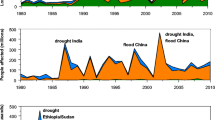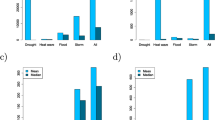Abstract
A unique historical data set describing the 142 storms producing losses in excess of $100 million in the United States during the 1950–89 period were analyzed to describe their temporal characteristics. These ‘weather disasters’ (WDs) caused $66.2 billion in losses, 76% of the nation's insured losses in this period. Disasters were most prevalent in the south, southeast, northeast, and central U.S., with few in and west of the Rockies. The incidence of WDs was high in the 1950s, low in the 1960s-early 1970s, and peaked in the 1980s. Losses due to WDs peaked in the 1950s, again in the late 1960s, and with a lesser peak after 1985. The areal extent of storm losses peaked after 1975 and was least in the 1960s. The temporal variations of the three storm measures (incidence, losses, and extent) had poor agreement, and agreed only when they peaked in the 1950s. Regionally-derived time distributions of WDs showed marked north-south differences with a U-shaped 40-year distribution in the northern half of the nation, whereas southern regions had a relatively flat trend until achieving a peak in the 1980s. The temporal distributions of hurricane-caused disasters differed regionally, with the distributions in the southern, southeastern, and northeastern U.S. each quite different. Temporal distributions of thunderstorm and winter storm-produced disasters were regionally more uniform. The national 5-year WD frequencies correlated moderately well with annual mean temperatures which explained 40% of the variability found in WDs during 1950–89. Weather disasters peaked in the relatively warm-dry 1950s and again in the warm-wet 1980s, and were least in the cool-wet 1960s and 1970s. The distribution of WDs during 1950–89 appears positively related to the temporal fluctuations in cyclonic activity.
Similar content being viewed by others
References
Agee, E. M.: 1991, ‘Trends in Cyclone and Anticyclone Frequency and Comparison with Periods of Warming and Cooling over North America’, J. Clim. 4, 263–267.
Friedman, D. G.: 1988, ‘Implications of Climate Change for the Insurance Industry’, Proc. North-American Conf. on Preparing for Climate Change, Climate Institute, Wash., D.C., 389–400.
Karl, T. R. and Koseilny, A. J.: 1982, ‘Drought in the United States, 1895–1982’, J. Clim. 2, 313–329.
Kelly, D. L., Schaefer, J. T., and Doswell III, C. A.: 1985, ‘Climatology of Nontornadic Severe Thunderstorm Events in the United States’, Mon. Wea. Rev. 113, 1997–2014.
Lamb, P. and Changnon, S. A.: 1982, ‘On the “Best” Temperature and Precipitation Normals: The Illinois Situation’, J. Appl. Meteor. 20, 1383–1390.
Schneider, S. H.: 1990, ‘The Global Warming Debate Heats Up: An Analysis and Perspective’, Bull. Amer. Meteor. Soc. 71, 1292.
Parker, S. S., Hawes, J. T., Colucci, S. J., and Hayden, B. P.: 1989, ‘Climatology of 500 mb Cyclones and Anticyclones, 1950–85’, Mon. Wea. Rev. 117, 558–570.
Whittaker, L. M. and Horn, L. H.: 1981, ‘Geographical and Seasonal Distribution of North American Cyclogenesis, 1958–1977’, Mon. Wea. Rev. 109, 2312–2322.
Author information
Authors and Affiliations
Rights and permissions
About this article
Cite this article
Changnon, S.A., Changnon, J.M. Temporal fluctuations in weather disasters: 1950–1989. Climatic Change 22, 191–208 (1992). https://doi.org/10.1007/BF00143027
Received:
Revised:
Issue Date:
DOI: https://doi.org/10.1007/BF00143027




